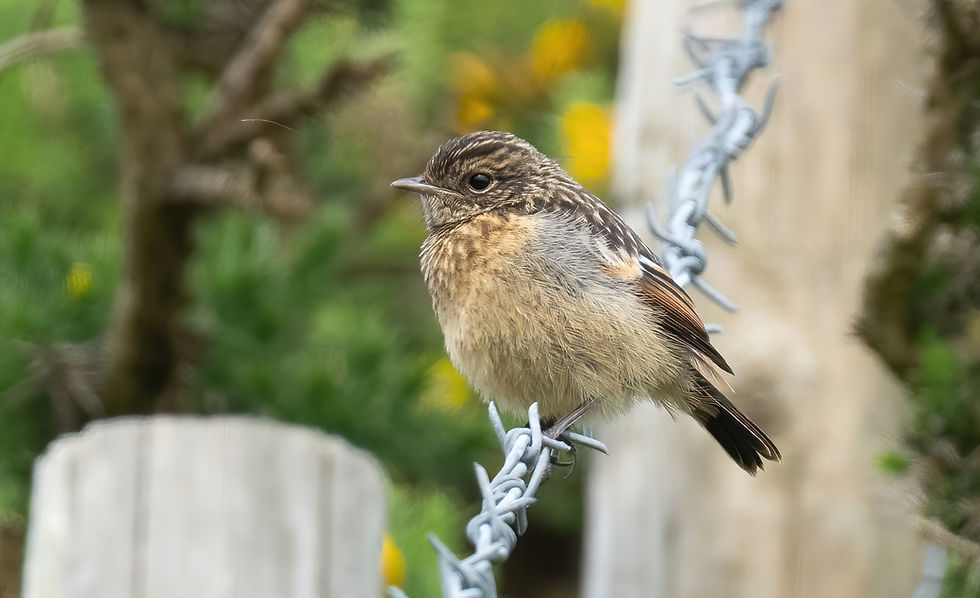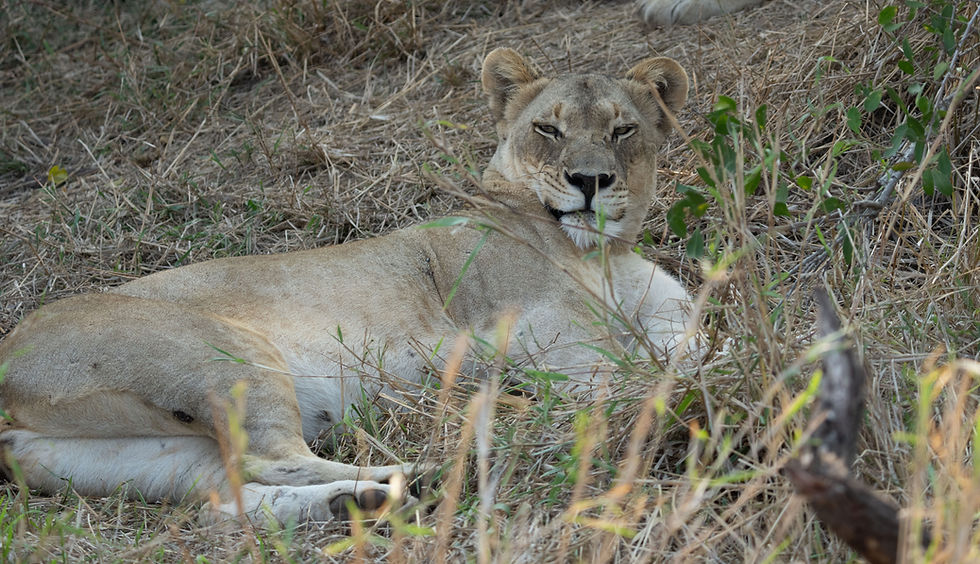The first bit of good news (for me) was that the Oldenburgh was still in repair so it meant helicopters to and from Lundy instead of travel via sea vessel. On arrival I headed straight to Pondsbury in the hope of seeing the long staying Purple Heron. No sign so I decided on a walk round South End. Walking past the church I heard an unusual call that I knew I'd heard before, but I just couldn't place it. I then saw a small finch flying towards the church but apart from the fact it was small with a bouncy flight I couldn't see any id features. After searching round the church to no avail I headed towards Benjamin's Chair where I saw a small finch on it's own busily feeding on the ground. I lifted my bins and there was a stonking male Serin. The call then clicked into place.

What a start, just under two hours in and I'd had a Lundy tick ! Another three visits to Pondsbury that day but continued to dip on the Purple Heron.
Friday 19 May: woke to a rolling mist which quickly burnt off. Off to Pondsbury but I wasn't hopeful and indeed as I scanned there was no sign of the Heron. Then up from Punchbowl flew in the Purple Heron. I watched it fly around and land on Pondsbury. Another Lundy tick.



Millcombe felt quiet with most of yesterday's bird having cleared out but as usual elsewhere there were Wheatears, Peregrines, Stonechats and a Lesser Redpoll to keep the interest.
Saturday 20 May and the winds had turned ENE and it was sunny so a trip to North End. Yellow Wagtail and lots of Wheatears on route with seven males of the latter chasing one another around the tops steps of North Point.
female Wheater

Climbing down to Seal Steps I spent several hours watching seals, Razorbills, Guillemots and Puffins.
Bridled Guillemot

Razorbill

Puffins


Then a surprise visit by two Turnstones and a Purple Sandpiper - both flybys. Hirundines were pouring off the North End and in two hours I recorded 297 Swallows and 78 House Martins and that was while taking photographs so there will have been many more. With decreasing winds and full sunshine it was another great Lundy day.
Sunday 21 May and I finally caught up with the Hooded Crow in Tillage Field. It had become a bit of a long-standing joke that I'd missed it so many times since my arrival.
Hooded Crow

Surprise of the day was an immature Cormorant fishing in Pondsbury. It was later seen catching a fish which put to an end the discussions about Pondsbury and its disappearing fish stock. I spent much of the day trying to photograph Wheatears with colour rings, with some success. A male Kestrel was continuously hunting in south-west field with no sign of a female so hopefully she was sat on eggs or chicks.

Monday 22 May and another sunny if breezy day. At Jenny's Cove I counted 141 Puffins , all on the water and then I was treated to a Peregrine Spectacular. One bird was hunting the top of Jenny's and as is usual the gulls went up and started to harass it. Usually this lasts a minute or two and they peel off. This time however one particular Lesser Black-backed Gull just didn't give up resulting in some near contact, with the Peregrine rolling over onto it's back mid flight and pushing it's talons up towards the Gull.
The chase is on.........



Peace at last !

As I returned back south I saw a Spotted Flycatcher by the pig pens so quickened my pace thinking if there's birds up here then Millcombe must be good. I wasn't disappointed as arriving at the top of the valley there were some 25 Spotted Flycatchers. Given their mainland scarcity in the last 15 years this was a marvellous sight. Throw in the numerous singing Whitethroats, Sedge and Willow Warblers and this was quite an end to the day.
Spotted Flycatcher

Tuesday 23 May started overcast but quickly cleared. I started in Millcombe with a family of Stonechats.
Male Stonechat

Female Stonechat

Young Stonechat

Still lots of Spotted Flycatchers, in fact more than the previous day with a total count of 57 birds and my first Cuckoo of the year. Off south end I watched a continuous stream of hirundines passing north with more than 100 Swifts. Another bird filled Lundy day.
Wednesday 24 May and winds still NNE with sunny skies. News that a Common Rosefinch had been heard singing in Millcombe had seven of us scouring the area for a sighting with the hope it could be a bright red male. No sign and after half an hour I wandered off down to the bottom gardens and then back up through the wood and eventually to the top of Millcombe where we had all previously stood. No-one was there ! So with the slight rising concern that everyone was watching it elsewhere I was about to head off up the east side path when a bird flew into a bush next to me. I fully expected this to be a House Sparrow and was amazed to find myself staring directly at a brown type Common Rosefinch. It sang once and shot off. I barely had time to lift the camera !
Common Rosefinch - male not in breeding plumage

In south-west field flash I found 2 Dunlin

and some 65 Wheatears in south-west field. This was probably an increase in sightings as opposed to any movement, as sideland breeding birds were coming up onto the plateau to feed. Tree Pipit heard overhead and Millcombe still had plenty of Spotted Flycatchers. Along the Upper East Side Path I saw a Peregrine make a pass at a passerine in Tillage field, it missed but I got the feeling it was going to have another go. I hunkered down and waited and then it came hurtling low over the ground and took a Starling as it rose in panic from the field.


Friday 26 May and the last full day. I was looking at a White Wagtail in Barton Field when I saw a flash of Yellow and expected to see a normal Yellow Wagtail but this one had a dark head - I've always found the different races of Yellow Wag difficult to identify so was keen to get some pictures to help with the identification. The bird was actively feeding round the Ponies and occasionally would sit up on their pooh which made it easier to photograph. After much deliberation I put it down to the thunbergi race - Grey-headed Wagtail.


While I was watching the wagtail I received news of a Red-throated Pipit at Pondsbury seen and heard by Tim Jones. Off I went accompanied by Luke the new seasonal warden. We searched for a while but were not successful. I decided to return to south end and as I was almost out of sight of Pondsbury made one final glance back to see Luke waving his arms about and pointing. He had seen and heard it, albeit at distance. I returned and we both saw the bird again in flight but more importantly heard it call. Not the greatest sighting of a Ripit but a fabulous end to a great trip.
Next up a bit of time travel back to the previous 10 days spent in Northern Ohio looking for American Warblers..............................




































































































